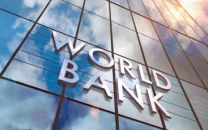SBP sees risks to economic recovery
Governor's report highlights climate, global trade shifts as challenges

Despite signs of macroeconomic recovery in fiscal year 2024-25, Pakistan faces a complex web of challenges that could jeopardise the fragile stability achieved over the past two years, according to the State Bank of Pakistan's (SBP) Governor's Annual Report 2024-25, released on Friday.
According to the Governor's Annual Report 2024-25, presented to Parliament on Friday, SBP Governor Jameel Ahmad noted that the central bank's disciplined monetary stance, exchange rate management, and financial sector oversight helped anchor stability. However, he warned that the gains remain fragile amid global trade disruptions, regional tensions, and domestic structural weaknesses.
"The immediate forecast horizon remains challenging in view of global tariff policy shifts and the 2025 floods that damaged agricultural output and disrupted supply chains," Ahmad stated, underscoring the risks to inflation, external balance, and fiscal consolidation.
The SBP pursued a cautious monetary policy throughout FY25, seeking to curb inflation while supporting growth. Between June 2024 and June 2025, the Monetary Policy Committee (MPC) slashed the policy rate by 1,100 basis points, marking one of the most significant easing cycles in recent years.
This move followed a sharp decline in inflation, which averaged 4.5% in FY25, down from 23.4% in the previous year. The central bank attributed this dramatic disinflation to subdued domestic demand, lower international commodity prices, and better food availability.
Yet, the SBP faced a dilemma in early 2025 – balancing stimulus with caution. Sticky core inflation, global tariff hikes led by the United States, and geopolitical uncertainty forced the bank to slow the pace of rate cuts in the second half of FY25.
"Despite the improving inflation outlook, the risk of premature monetary easing remained high," the report noted, adding that volatility in energy and food prices could reignite inflationary pressures.
The SBP's foreign exchange management was a key success story. Pakistan posted its first current account surplus in 14 years, amounting to $2.1 billion, supported by record workers' remittances and steady inflows from multilateral and bilateral partners, including the IMF's Extended Fund Facility (EFF).
The surplus allowed SBP to purchase $7.7 billion from the interbank market and rebuild reserves, contributing to exchange rate stability. The rupee depreciated by just 1.9% during FY25 compared to the volatility in previous years.
However, the central bank cautioned that the trade deficit widened as imports grew by 10.2%, reflecting a rebound in industrial demand and machinery imports. This, coupled with Pakistan's growing reliance on remittances, underscores structural weaknesses.
"Excessive dependence on remittances in an import-reliant economy may fuel inflationary pressures and reduce export competitiveness," the SBP warned, calling for diversification of export sectors and greater productivity-driven growth.
The banking sector's assets rose to 52.4% of GDP, while solvency and profitability indicators remained strong. Yet, the sector faced liquidity pressures due to slowing deposit growth and higher currency circulation, reflecting public uncertainty amid regional instability. The SBP mitigated this by enhancing open market operations (OMOs).
Microfinance Banks' (MFBs) non-performing loan ratios declined, and aggregate losses fell threefold in FY25. Still, the sector's capital adequacy ratio weakened, requiring continued regulatory vigilance.
The SBP, in collaboration with the government and the World Bank, launched the Climate Risk Fund-I under the Resilient and Accessible Microfinance (RAM) initiative to support small farmers affected by floods and promote climate-resilient lending practices.
As part of its modernisation drive, the SBP strengthened Pakistan's digital payments infrastructure. It established Raast Payments Pakistan (Pvt) Ltd, a wholly owned subsidiary to oversee operations of the national instant payment system, and introduced PRISM+, an upgraded real-time settlement platform with enhanced processing and securities depository features.
Despite these advancements, challenges persist in promoting financial inclusion, especially for women and low-income groups. To address this, the SBP launched the National Financial Inclusion Strategy (NFIS) 2024-28 and the National Financial Education Roadmap (NFER) 2025-29, targeting 75% inclusion by 2028 and reducing the gender gap to 25%.
The report highlighted that while inflation has eased further to 4.2% in Q1-FY26, the 2025 floods, coupled with global tariff disputes and volatile energy prices, pose renewed risks. The SBP warned inflation could temporarily exceed the 5-7% target range in the coming quarters before stabilising in FY27.
Moreover, fiscal slippages remain a threat. Despite achieving a primary surplus of 2.4% of GDP in FY25, reconstruction spending and potential untargeted subsidies could strain public finances if tax mobilisation falters.




















COMMENTS (1)
Comments are moderated and generally will be posted if they are on-topic and not abusive.
For more information, please see our Comments FAQ